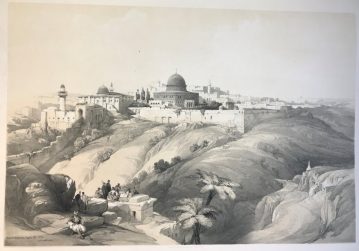The Holy Land, Syria, Idumea, Arabia, Egypt and Nubia. Syria, Idumea, Arabia, Egypt and Nubia. After Lithographs by Louis Haghe from Drawings made on the Spot by David Roberts R. A. With Historical Descriptions by The Rev. George Croly, L.L.D. THREE VOLUMES.
Roberts, David.
Synopsis
The most important and elaborate ventures of 19th century publishing. David Roberts (1796-1864) was born in Stockbridge near Edinburgh, and at the age of ten apprenticed to house painter Gavin Buego. After his apprenticeship he continued to work for Buego carrying out work on imitation stone-work and panelling at Scone Palace and Abercairney Abbey. By 1818 Roberts had become assistant scene painter at the Pantheon Theatre in Edinburgh, moving on to theatres in Glasgow, and finally in 1821 to the Drury Lane Theatre in London, where he worked with Clarkson Stanfield. Both artists exhibited at the Society of British Artists, Royal Academy and British Institution, and by 1830 Roberts was firmly established as a topographical artist and was able to give up his theatre work. In these early years he toured the Continent and Scotland, and in 1832-1833 visited Spain.
In 1838, he made plans for his journey to the Near East, inspired by a love of artistic adventure. Departing in August 1839 for Alexandria, he spent the remaining part of the year in Cairo, visiting the numerous tombs and sites. In February of the following year he set out to cross the desert for the Holy Land by way of Suez, Mount Sinai, and Petra, arriving in Gaza, and then on to Jerusalem, concluding his tour visiting the biblical sites of the Holy Land for several months. He returned to England at the end of 1839. The drawings of his tour were submitted to F.G. Moon in 1840, who arranged to bring out a work illustrative of Scripture history, paying Roberts £3,000 for the copyright of the sketches, and for his labour in supervising Louis Haghes lithography. “In no other publication have the sites and buildings famous in sacred history and Eastern legend been so vividly represented. It is difficult to speak in sufficiently high terms of the beauty and interest of the varied subjects in this great work. It represents the results of Roberts’s travels in the East during the years 1838 and 1839. The extraordinary merit and interest of the drawings which he exhibited on his return created a great sensation. The fidelity of his accurate pencil, his skilful adherence to truth of costume and surroundings, his attention to characteristic effect in architecture and landscape, won immediate recognition and praise. Commissions from royal and other patrons of art crowded upon him for pictures of his Eastern subjects, and a publisher, F. G. Moon, was soon found to undertake their reproduction for wider circulation. The result was the present work with about two hundred and fifty plates.
Bibliographic references: Abbey Travel I, 272 & II, 385; Blackmer 1432; Gay 25; Ibrahim-Hilmy II,p.176; Lipperheide Ma27; Röhrict 1984; Tobler p. 229; Tooley 402.








